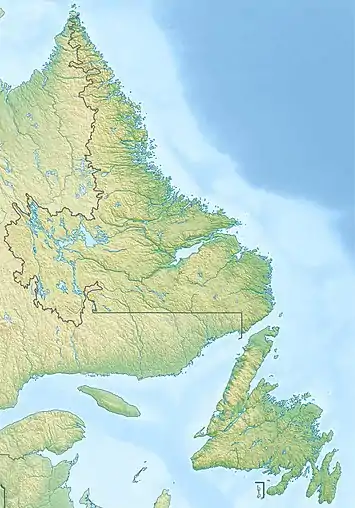NunatuKavut people
The NunatuKavummiut (also called the people of NunatuKavut, Labrador Metis or Inuit-metis) are an Aboriginal people of Canada. They live in central to southern Labrador, and are of mixed Inuit and European heritage. They are unrelated to the Red River Metis of Western Canada, and not considered "Metis".
| Regions with significant populations | |
|---|---|
| Languages | |
| Newfoundland English, Inuttut | |
| Religion | |
| Protestant, Evangelical Christianity, Animism. | |
| Related ethnic groups | |
| Inuit peoples |
Nunatuĸavut or NunatuKavut means "Our ancient land" in the ancestral Inuttut dialect of the NunatuKavummuit. The Inuit region encompasses Southern Labrador, from the Grand River (Newfoundland name: Churchill River), South to Lodge Bay and West to the extent of the official border between Quebec and Labrador. However, the land use area is much more extensive.[1]
Nomenclature
The exact term for NunatuKavut's people is uncertain. Historically, terms such as "half-breeds" or "settlers" were used (the former was also commonly used to refer to the Métis).[2] Terms today include "Inuit-Métis", "Southern Inuit" and "Kablunângajuit".
History
Arrival in southern Labrador
The people are the sole ancestors of the southern Inuit of Labrador who have, they claim, continuously occupied and used the region for almost a thousand years, long before the Government of Newfoundland made any real foray into the area in the early 20th century.[3]
According to one theory, the Inuit arrived in Labrador in the 15th century from Baffin Island. Archeological evidence shows they lived as far south as the Sandwich Bay (Newfoundland and Labrador) area.[4]
Contact with Europeans
The Inuit were in conflict with the Basque and French whalers beginning in the mid-1500s.
Treaty of 1765
Following the defeat of France in the Seven Years' War, Britain laid claim to Labrador. The British governor of Newfoundland Sir Hugh Palliser signed a treaty with the southern Labrador Inuit in 1765.[5]
Distribution
NunatuKavut consists of a region of southern Labrador that encompasses communities from Lodge Bay (located on the Lodge River) to the communities located on the coast of Sandwich Bay (Paradise River and Cartwright). However, there are notable populations of people of mixed European and Inuit descent in other parts of Labrador too. Many Inuit in the southern parts of Nunatsiavut are descended from fur traders that worked in the region. NunatuKavut also has a large diaspora in many other parts of Labrador such as Happy Valley-Goose Bay and the communities located along the Strait of Belle Isle and NunatuKavut also has a large diaspora living on the island of Newfoundland. Many residents of the Quebec community of St. Augustine (known officially as "Saint-Augustin") are also of Inuit and European descent.[7]
Organization
The organization claiming to speak for the Labrador Inuit-Metis, was originally called the Labrador Métis Nation, and was formed in the early 1980s. In 2010 that group changed its name to Nunatukavut (the same as the territory they claim).[8] They are members of the Congress of Aboriginal Peoples along with other non-Status Aboriginal groups.[9]
Land claim
The Labrador Inuit-Metis claim NunatuKavut as their homeland, and are in process of launching an Aboriginal land claim with the Canadian courts. They are also active in the debates over the Lower Churchill hydroelectric project, and the dam at Muskrat Falls.[10]
See also
Further reading
References
- The forgotten Labrador (Cleophas Belvin; ISBN 0-7735-3151-3; (bound))
- https://www.erudit.org/en/journals/etudinuit/2015-v39-n1-etudinuit02454/1036085ar/
- The Story of Labrador by Bill Rompkey Publisher: Montreal : McGill-Queen's University Press, 2003. ISBN 0-7735-2574-2 DDC: 971.82 LCC: FC2149.4 Edition: (bound)
- http://www.heritage.nf.ca/aboriginal/metis.html
- http://www.nunatukavut.ca/home/files/pg/british-inuit_treaty_1765.pdf
- Royal Commission White Paper on Renewing and Strengthening Our Place in Canada
- http://www.thelowernorthshore.com/lns/images/d/d1/St-Augustin_Hab-1-.pdf
- http://www.cbc.ca/news/canada/newfoundland-labrador/story/2010/04/13/nl-nunatukavut-413.html
- "Archived copy". Archived from the original on 2012-11-05. Retrieved 2012-11-29.CS1 maint: archived copy as title (link)
- "Archived copy". Archived from the original on 2012-10-06. Retrieved 2012-09-19.CS1 maint: archived copy as title (link)
